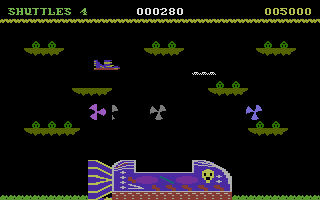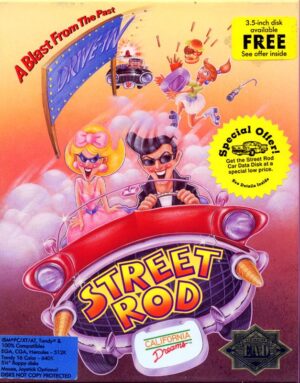Retro Replay Review
Gameplay
Cuthbert in Space delivers a tight, arcade-style gameplay loop that splits each level into two distinct challenges. The first “fuel stage” has Cuthbert piloting his compact shuttle from floating platform to platform, carefully grabbing one fuel pellet at a time and ferrying it back to the mothership at the bottom of the screen. This one-at-a-time mechanic adds a layer of strategic planning: you must decide whether to risk a direct route under fire or take a safer path that costs precious seconds.
(HEY YOU!! We hope you enjoy! We try not to run ads. So basically, this is a very expensive hobby running this site. Please consider joining us for updates, forums, and more. Network w/ us to make some cash or friends while retro gaming, and you can win some free retro games for posting. Okay, carry on 👍)
Hostile orbs glide unpredictably across the playfield at varying heights and speeds, forcing you to master both precision flying and quick trigger fingers. Your laser can blast these threats out of the sky, but ammo is limited, so every shot counts. The resulting tension keeps you glued to the controls as you juggle resource management, platform-hopping, and enemy avoidance in real time.
Once the fuel quota is met, the second “loot stage” begins. Objects rain down from the top of the screen—valuable cargo you must catch while dodging the same rogue orbs you faced earlier. Success requires pixel-perfect positioning, split-second reflexes, and an eye for unpredictable drop patterns. Each successive level ramps up the speed and density of falling loot, delivering a rewarding sense of progression.
Between planetary runs, Cuthbert’s voyage through deep space unfolds via a text-only interface. Random events like damaged systems or stray meteors force you into mini text-puzzles: you’ll adjust coordinate settings under a ticking timer to prevent explosive consequences. These brief interludes break up the action nicely, providing narrative context and a fresh test of nerve outside the shooter framework.
Graphics
Visually, Cuthbert in Space embraces a bold, retro pixel art style that pays homage to classic arcade titles like Joust. The color palette leans heavily on bright primaries—icy blues for the void, glowing oranges for hazards, and crisp whites for Cuthbert’s shuttle—ensuring each element stands out clearly against the starfield backdrop.
Character sprites are charmingly minimal yet expressive. Cuthbert’s little avatar, helmet and all, bounces with just enough detail to feel alive, while the orbs and falling loot are distinct shapes you can read at a glance. Animations are smooth and snappy, making every jump, blast, and docking maneuver a pleasure to watch.
Stage backgrounds feature subtle parallax scrolling that adds depth to the action layers, giving a tangible sense of altitude as you weave between platforms. Explosions and laser beams pop with satisfying pixel bursts, and the mothership’s blinking lights serve as both a gameplay goal and a visual anchor.
Even the text-only interludes maintain a coherent aesthetic: the monospaced font, blinking cursor, and color-coded prompts evoke vintage computer terminals, reinforcing the game’s old-school sci-fi vibe without feeling out of place.
Story
Cuthbert’s spacefaring saga is delightfully straightforward: take off, gather resources, survive the hazards, and repeat until the galaxy is secure. There’s no sprawling narrative or complex lore—just the indomitable spirit of a hero on a mission, and that simplicity is part of its charm.
Occasional text encounters hint at deeper mysteries. A stray transmission might warn of pirate activity, compel you to perform emergency repairs, or offer cryptic coordinates to hidden salvage. These snippets of dialogue, though brief, create a sense of adventure beyond the core arcade loop.
Dialogue is sparse but often tongue-in-cheek, capturing Cuthbert’s plucky personality. He quips when a mission goes awry and sighs in relief at each successful docking. This lighthearted tone reinforces the pick-up-and-play accessibility while giving the game a dash of character.
Ultimately, the story exists to frame the action rather than overshadow it. If you’re looking for a deep narrative RPG, this isn’t it—but if you enjoy classic arcade heroes with a touch of sci-fi humor, Cuthbert’s journey will keep you invested from launch to final boss.
Overall Experience
Cuthbert in Space strikes an excellent balance between challenging arcade action and accessible pick-up-and-play design. Each level feels like a self-contained test of skill, and the gradual ramp-up in difficulty ensures you’re always honing your reflexes without ever feeling unfairly punished.
Audio design leans on punchy bleeps, engine hums, and crisp laser blasts that perfectly complement the visuals. There’s no orchestral score here—just functional, rhythmic sound effects that drive home each moment of tension and triumph.
The text-puzzle interludes provide welcome variety, breaking up the main stages with a different type of urgency. These mini-challenges give you breathing room while underscoring the stakes of space travel: one wrong coordinate and it’s game over. They’re short but memorable, adding narrative texture to the core gameplay.
For fans of retro shooters, high-score chasers, or anyone seeking a quick-to-learn but hard-to-master arcade romp, Cuthbert in Space offers hours of addictive fun. Its straightforward premise, coupled with tight controls and escalating difficulty, makes it a standout title for players who crave pure, unadulterated action in a charming pixel-perfect package.
 Retro Replay Retro Replay gaming reviews, news, emulation, geek stuff and more!
Retro Replay Retro Replay gaming reviews, news, emulation, geek stuff and more!









Reviews
There are no reviews yet.